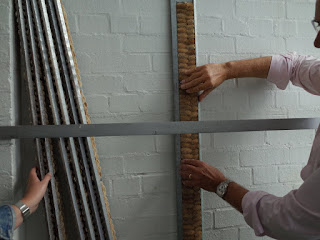
Last week, I had one of the best days of my working life to date. It’s been 7 years since I started visiting factories around the UK but until now I’ve not had the chance to incorporate it into my day job too much.
At Winkreative, we’ve been lucky enough to work with the wonderful team at Begg & Co., a cashmere scarf and throw maker of the highest quality, over the last few years — taking the brand from idea to firmly established in a relatively short amount of time. This has only been possible through the team’s expertise which comes from Alex Begg, a company with over 150 years of experience in producing the finest scarves for some well-known luxury fashion brands.
Given I was there for the day with work, I sadly didn’t have the chance to interview the workers themselves, but we were shown around by David Woodhouse, the technical director of Alex Begg. To spend a couple of hours with David is a real thrill for anyone with an interest in textile manufacturing — he has decades of experience and many a great anecdote.
The Alex Begg factory is in Ayr, an hour or so drive from Glasgow airport. It’s an unassuming set-up from the outside, sat opposite a grey block of flats on a side road in the town. Once inside it’s a treat. Machines old and state-of-the-art sit side-by-side, workers of all ages go about their incredibly intricate and painstaking work with quiet efficiency.
A few highlights from our two hour tour with David below:

A few highlights from our two hour tour with David below:

An incredible weaving machine, where the master weavers thread all the yarn through to begin making fabric.


Into the next room where we were shown these stunning machines that can weave like the clappers.

Before the scarves leave the factory for retailers, they go through a rigorous washing and, well, beating process. This machine was pummelling away. It's part of the reason why Alex Begg cashmere can be so soft.


For its scarves, Begg & Co. uses teasels, which have largely been pushed out of favour by metal ones over the last century. In the first photo, David is showing us how they can be packed into the frames. The frames are then placed on to a machine (second photo) with a rotating hub that the material is wrapped around. The momentum 'raises the nap'.
Brilliantly, David tracked down a teasel grower in Italy in order to ensure the best quality and size crop for Begg to use. The farmer has two fields just for Begg.

We also learnt about the origin of 'on tenterhooks'.... It turns out that it's related to the drying of fabric and ensuring it doesn't lose its shape. David recommended a book that covers textile terms — I need to ask him to remind me of its title.

This final image is of the press that all products go through before leaving the factory. The stacks of paper were sourced by David and are uniquely coated for the task. However, the production of them has ceased — so once it's gone, it's gone. Any producers of such items, do get in touch!
For more images of the visit, please head over to the M&I Facebook page.
-
The brilliant team at Make Works visited Alex Begg in 2013 and produced a nice video of goings-on at the factory.












